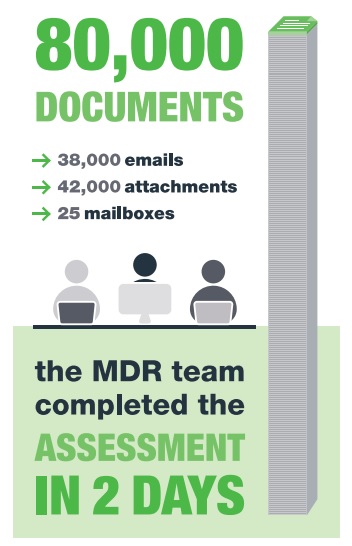The Challenges
Our client was representing a large financial institution (the Bank) who was obliged to respond to a s.33 notice issued under the ASIC Act (the Notice).
The Notice required the Bank to produce various documentation relating to its handling, during an eighteen-month period, of several default events in relation to corporate loan facilities held by the borrower. There was only one week remaining to respond to the Notice and assessment of relevance to specific questions in the Notice was required as well as determination of privilege and privilege basis.
Our client was told by the Bank it had, by selecting a wide date range to be certain to capture all relevant materials, identified a data set of approximately 30GB of unprocessed data. The Bank initially estimated this set comprised "approximately 10,000 – 15,000 emails" requiring review. This number did not include attachments.
The lack of certainty regarding the exact number of documents made it difficult for our client to determine appropriate resourcing or even know whether the review could be completed in the limited time available.

The Solution(s)
- Provide Proposal Options for Consideration
We were able to provide our client with various options for resourcing the first level review (FLR) depending on the various (and wide range of) possibilities of the exact number of documents within the data set. These proposals meant our client could be confident, regardless of the number of documents, we could deliver the documents to them in a timely manner.
- Allocating and Training a Sizeable Review Team
Our team has in-depth experience in responding to regulatory notices from a number of bodies so was able to commence the training of a team of over 50 reviewers on the particular subject matter of the transaction. The team was tested on the training and was able to develop a strong understanding of the subject matter in a short period of time.
This also meant the team was ready to commence FLR immediately upon the documents becoming available.
- Flexible Working Arrangements
The Review Team was able to commence work on a Saturday and continue during a weekend to meet the client's deadlines.
- Prioritising Custodians
After processing, the data set was found to contain approximately 80,000 documents, comprising 38,000 emails and 42,000 attachments – from around 25 custodians (mailbox holders).
We were able to work with our client to proceed with the review prioritising documents based upon which particular custodians our client believed were more likely to be central to the investigation.
Three categories of Priority were created. This then permitted FLR, QA and release of those documents to the client for second level review (SLR) in that order, minimising downtime for the SLR team and enabling them to commence reviewing highly relevant documents more quickly
Outcome
By utilising our processing resources in Australia and offshore, and extended weekend shifts for our offshore Review Team, the process from receipt of the unprocessed data through to release to our client of the coded data was completed in just 4 days. This was from receipt of data late on a Thursday to completion by Monday afternoon. The MDR review team itself completed the assessment of all 80,000 documents for responsiveness to the Notice and relevant documents for privilege within just two days.
This gave our client sufficient time within which it could conduct its SLR and ultimately enabled the Bank to meet the tight deadline imposed upon it in the ASIC notice.
Conclusion
We were able to effectively manage our client's review project despite an initially uncertain number of documents within an extremely tight timeframe.
